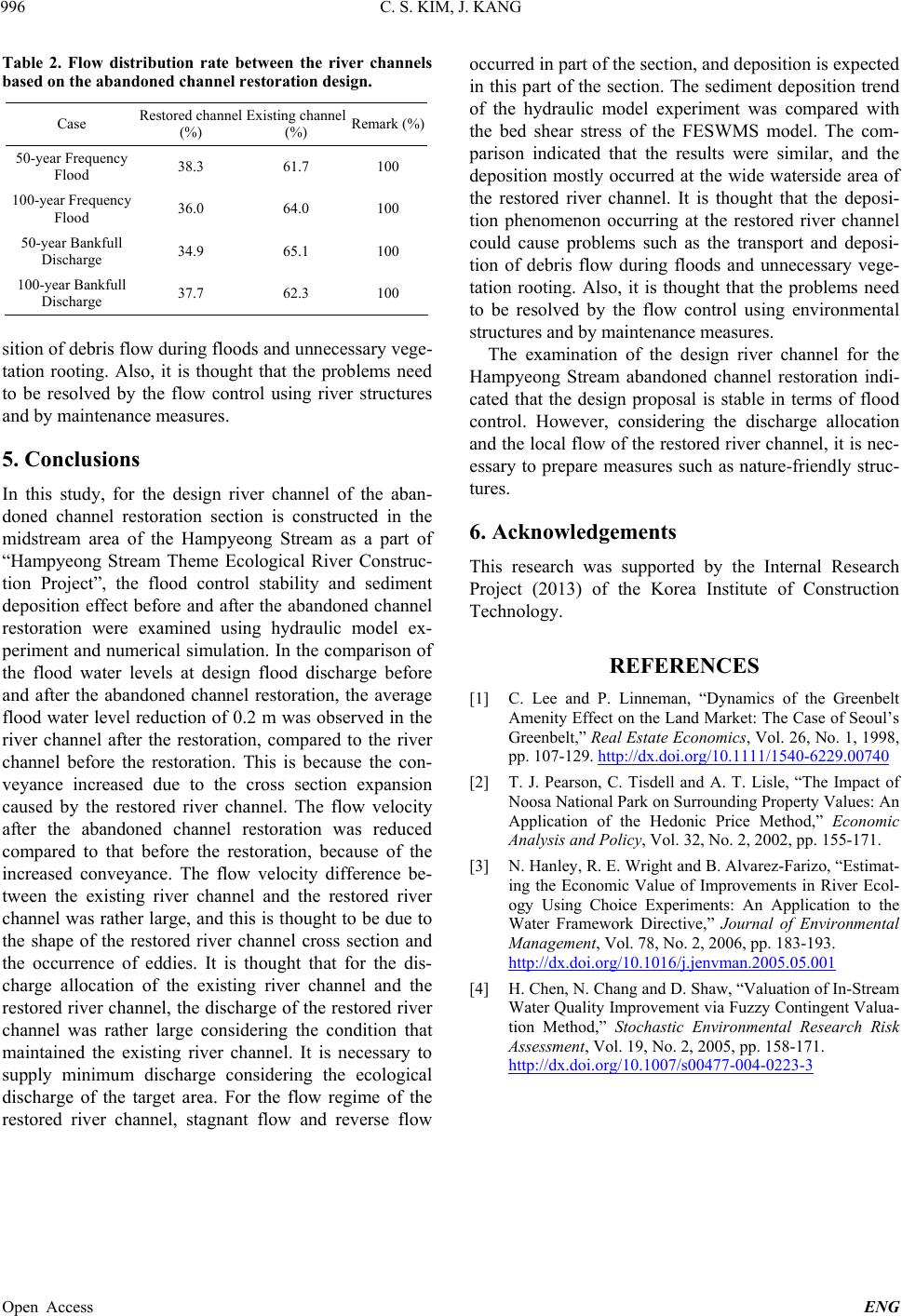
C. S. KIM, J. KANG
996
Table 2. Flow distribution rate between the river channels
based on the abandoned channe l restor ation design.
Case Restored channel
(%) Existing channel
(%) Remark (%)
50-year Frequency
Flood 38.3 61.7 100
100-year Frequ en cy
Flood 36.0 64.0 100
50-year Bankfull
Discharge 34.9 65.1 100
100-year Bankfu ll
Discharge 37.7 62.3 100
sition of debris flow during floods and unnecessary vege-
tation rooting. Also, it is thought that the problems need
to be resolved by the flow control using river structures
and by maintenance measures.
5. Conclusions
In this study, for the design river channel of the aban-
doned channel restoration section is constructed in the
midstream area of the Hampyeong Stream as a part of
“Hampyeong Stream Theme Ecological River Construc-
tion Project”, the flood control stability and sediment
deposition effect before and after the abandoned channel
restoration were examined using hydraulic model ex-
periment and numerical simulation. In the comparison of
the flood water levels at design flood discharge before
and after the abandoned channel restoration, the average
flood water level reduction of 0 .2 m was observed in the
river channel after the restoration, compared to the river
channel before the restoration. This is because the con-
veyance increased due to the cross section expansion
caused by the restored river channel. The flow velocity
after the abandoned channel restoration was reduced
compared to that before the restoration, because of the
increased conveyance. The flow velocity difference be-
tween the existing river channel and the restored river
channel was rather large, and this is th ought to be due to
the shape of the restored river channel cross section and
the occurrence of eddies. It is thought that for the dis-
charge allocation of the existing river channel and the
restored river channel, the discharge of the restored river
channel was rather large considering the condition that
maintained the existing river channel. It is necessary to
supply minimum discharge considering the ecological
discharge of the target area. For the flow regime of the
restored river channel, stagnant flow and reverse flow
occurred in part of the section, and deposition is exp ected
in this part of the section. The sediment deposition trend
of the hydraulic model experiment was compared with
the bed shear stress of the FESWMS model. The com-
parison indicated that the results were similar, and the
deposition mostly occurred at the wide waterside area of
the restored river channel. It is thought that the deposi-
tion phenomenon occurring at the restored river channel
could cause problems such as the transport and deposi-
tion of debris flow during floods and unnecessary vege-
tation rooting. Also, it is thought that the problems need
to be resolved by the flow control using environmental
structures and by maintenance measures.
The examination of the design river channel for the
Hampyeong Stream abandoned channel restoration indi-
cated that the design proposal is stable in terms of flood
control. However, considering the discharge allocation
and the local flow of the restored river channel, it is nec-
essary to prepare measures such as nature-friendly struc-
tures.
6. Acknowledgements
This research was supported by the Internal Research
Project (2013) of the Korea Institute of Construction
Technology.
REFERENCES
[1] C. Lee and P. Linneman, “Dynamics of the Greenbelt
Amenity Effect on the Land Market: The Case of Seoul’s
Greenbelt,” Real Estate Economics, Vol. 26, No. 1, 1998,
pp. 107-129. http://dx.doi.org/10.1111/1540-6229.00740
[2] T. J. Pearson, C. Tisdell and A. T. Lisle, “The Impact of
Noosa National Park on Surrounding Property Values: An
Application of the Hedonic Price Method,” Economic
Analysis and Policy, Vol. 32, No. 2, 2002, pp. 155-171.
[3] N. Hanley, R. E. Wright and B. Alvarez-Farizo, “Estimat-
ing the Economic Value of Improvements in River Ecol-
ogy Using Choice Experiments: An Application to the
Water Framework Directive,” Journal of Environmental
Management, Vol. 78, No. 2, 2006, pp. 183-193.
http://dx.doi.org/10.1016/j.jenvman.2005.05.001
[4] H. Chen, N. Chang and D. Shaw, “Valuation of In-Stream
Water Quality Improvement via Fuzzy Contingent Valua-
tion Method,” Stochastic Environmental Research Risk
Assessment, Vol. 19, No. 2, 2005, pp. 158-171.
http://dx.doi.org/10.1007/s00477-004-0223-3
Open Access ENG